
BOO! When Bela Lugosi met Old Mother Riley
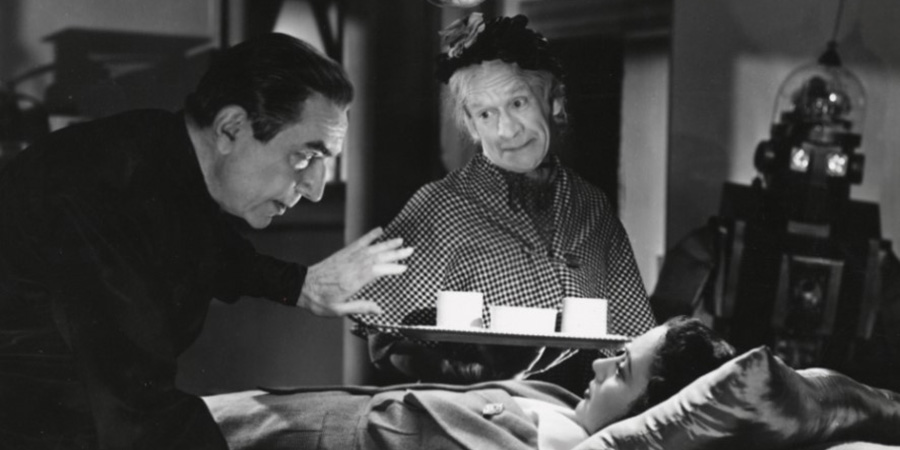
Halloween is upon us once again, and that means horror flicks, tricks or treats and costumed freaks, not forgetting the funk of forty-thousand years, and, of course, good old Dracula. One of the most memorable incarnations of this mirror-shy monster was the Hollywood star Bela Lugosi, who wandered through countless movies from the 1930s through to the 1950s wearing a cape, fangs and a very menacing expression. The bright world of British comedy was the last place one would have expected to find him casting his sinister shadow, but, late on in his career, that is the very place where Lugosi was lured.
Born Béla Ferenc Dezsö Blaskó in Hungary in 1882, and an actor since his teens, he had moved to the United States in the early Twenties and first starred as Count Dracula in a 1927 Broadway adaptation of the Bram Stoker novel. Moving with the play to California the following year, he soon commenced a Hollywood career that would see him feature in more than one hundred movies over the course of the next thirty years.
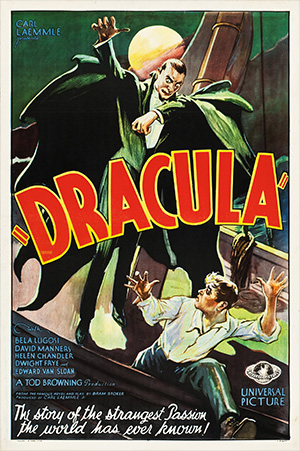
With his dark and sinister looks and deep, deliberate and thickly-accented delivery, Lugosi made such an immediate impact on the horror genre - his early credits included Dracula (1931), Murders in the Rue Morgue (1932), The Whispering Shadow (1933), The Black Cat (1934), Mark of the Vampire (1935), The Invisible Ray (1936) and Son of Frankenstein (1937) - that he rapidly became one of the most-recognisable stars in the industry.
It was a bitter-sweet experience for him, because, as much as he enjoyed the material benefits of success, he grew increasingly frustrated by the fact that he was so seldom now offered roles other than exotically menacing monsters and madmen. 'Considering that before Dracula I had never, in a long and varied career on the stage of two continents, played anything but leads and straight characters,' he later reflected, 'I was both amused and bitterly disappointed.'
Things grew even worse for him once the Second World War was over, when the experience of real horror seemed to have sated the public's appetite for its fictional equivalent, and Lugosi found himself being pushed even further into self-parody by playing (as one critic cruelly put it) 'tiresome freaks' in such comedies as Zombies on Broadway (1945), Genius at Work (1946) and Abbott and Costello Meet Frankenstein (1948).
Now ignored by the major studios and struggling for work, and dogged by niggling injuries and nagging illnesses, he drifted deep into an addiction to drinks and drugs. Dulled by dangerous daily doses of morphine and methadone (the latter of which he had first grown dependent on during an early visit to Britain: 'In those days no prescription was required for the methadone in England,' he later confessed. 'So I bought a big boxful and brought it back to this country'), he had only a past to ponder.
'Never has a role so influenced and dominated an actor's life as has the role of Dracula,' he would lament. 'He has, at times, infused me with prosperity and, at other times, he has drained me of everything... It's a living, but it's also a curse... It's Dracula's curse.'
It was at this point, as he despaired at the apparent death of his career, that a chance of a resurrection suddenly presented itself to him in the form of an offer to return to the stage in England. John Mather, a Scottish-born cigar-chomping producer with a background mainly in musicals, had heard (via a long-time Lugosi fan and budding film-maker called Richard Gordon (pictured with Lugosi, below)) that the half-forgotten star was desperate for work, and, after witnessing the likes of Danny Kaye and Judy Garland fly over to Britain to be seen and celebrated in the flesh, he had decided that even Lugosi (whose old movies were still being shown in the UK) might attract a decent-sized audience.
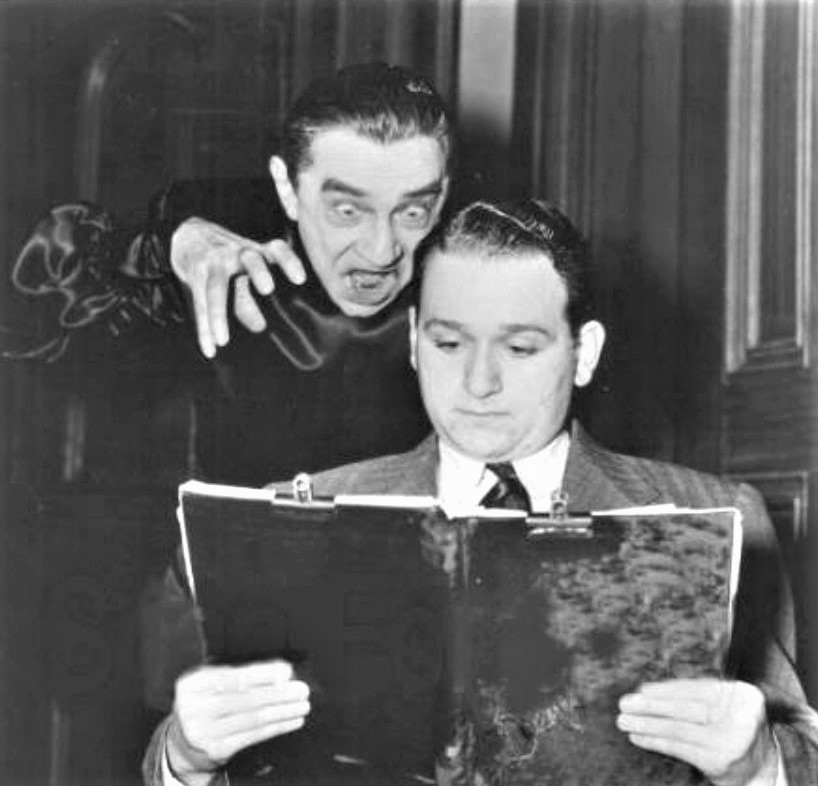
Lugosi was to play the part of Dracula, once again, in a new adaptation of the play staged by Mather's Chartres Productions. The plan was to tour the provinces over the course of about six to eight weeks, and then move to London's West End for a run at the Garrick Theatre, with whom Mather had already secured a verbal agreement to host the production.
Surprised and delighted to receive any kind of offer, and long resigned to his Draculean fate, the ageing actor was quick to accept. This could be the catalyst, he realised, to clean-up his life and recover his career.
Lugosi arrived at Southampton, on the S.S. Mauretania, on 10th April 1951. Accompanied by Lilian, his fourth and current wife, he was met by Mather, put in a limousine, and taken off to London, where a champagne reception was held in his honour. For this one brief moment, at least, Lugosi was able to feel once again that he had the world at his feet.
'My husband has been looking forward to this appearance in England,' Lillian told the reporters. 'He has dreamed for a long time of playing to British audiences.' Bela himself added: 'Yes, it really means something to be received on the English stage. I am hoping that we are really going to please.'
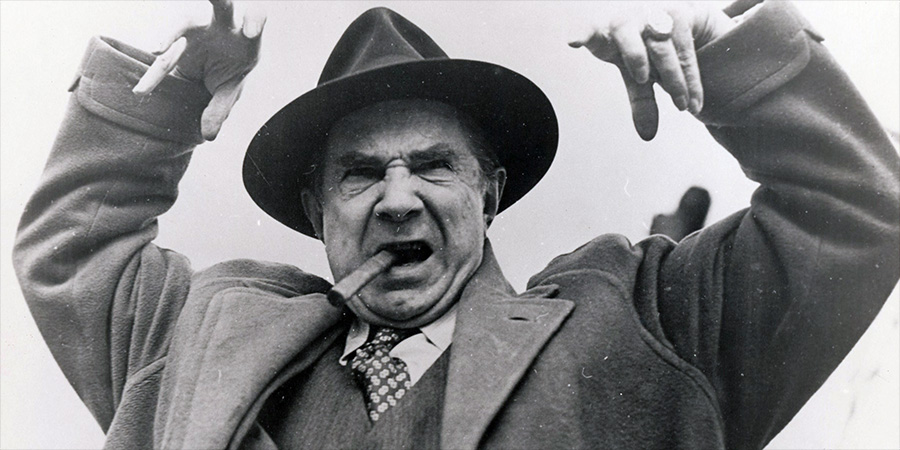
Problems, however, would plague the tour right from the beginning. When Mather, in a room above a pub on Pont Street, watched the first couple of days' rehearsal as a frail Lugosi (looking as though 'he was going to die') practically slept-walked his way through the role, he was already wondering whether or not he should cancel the whole production.
More worries arose as the touring crew got to work on the special effects. Dracula's entries and exits needed to be accompanied by an eerie-looking fog, but the stage engineers struggled to get the smoke coming through the pipes at the right power and pace. An electrical company was supposed to send one of its specialists up for a week to ensure that all of the 'atmospheric' lighting tricks would work, but, after he failed to turn up, it was left to local technicians to proceed rather more slowly via hazardous trial and error.
Advance sales were slightly more encouraging. Several movies from different phases of Lugosi's long career were currently being shown again in British cinemas - including White Zombie (1932), Frankenstein Meets the Wolf Man (1943), Ghosts in the Night (1943) and Scared to Death (1947) - so he remained a familiar name. The management team also boosted interest by indulging in a few press-friendly gimmicks, such as guaranteeing the presence in every theatre of nursing staff to attend to those overly distressed by the sight of Dracula ('Don't come,' the posters warned, 'if you have a weak heart!').
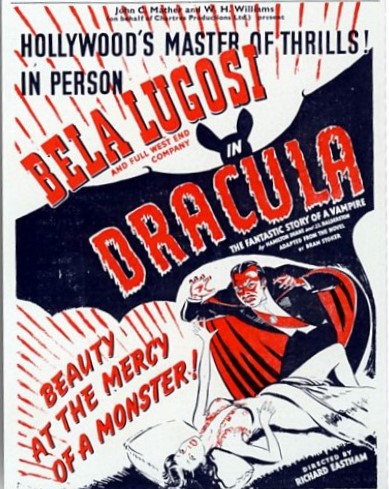
The star himself, it seems, was selective enough in what he read and saw to feel convinced that the production was going to do what it had promised and make him shine again. He was particularly buoyed by how positive the reaction was from the people he met face-to-face. 'eople all recognise me,' he enthused, 'and tell me of their like for me, in the street, in the shops, at the hotel, the porter, the taxi man...'
It soon became evident, however, that the tour would be much more reliant on sustaining the curiosity value of seeing a Hollywood legend step down from the screen and on to the stage, than it was on either the content of the play or the quality of the supporting cast. From the first night, at the Theatre Royal in Brighton on 30th April, the creaking production struck many as nothing more than a harmless exercise in camp nostalgia.
The reviews, in general, were kind to Lugosi while critical of much of what went on around him. 'His performance,' wrote one observer, 'is characterised by a majestic calmness which suggests that, while he may have supped full of horrors, his digestion is by now so perfectly attuned to the diet that there is no cause whatever for us to take alarm. He would, it seems, have us relax in our seats and relish him, rather than sit on their edges looking anxiously for their first-aid attendants who are present at the performance. This is not, in fact, lick-lipping horror: Lugosi's tongue is probably never far away from his cheek.' His only challenger for the acting honours, the critic added, 'was the fog which he ejected from his clothes when making entrances and exits'.
The situation behind the scenes, however, would soon start growing increasingly tense. The production was losing money, and badly needed the greater revenue that would come after its transfer to the West End, but the Garrick still had a play that was performing well, and tentative talks with other theatres failed to find a suitable alternative.
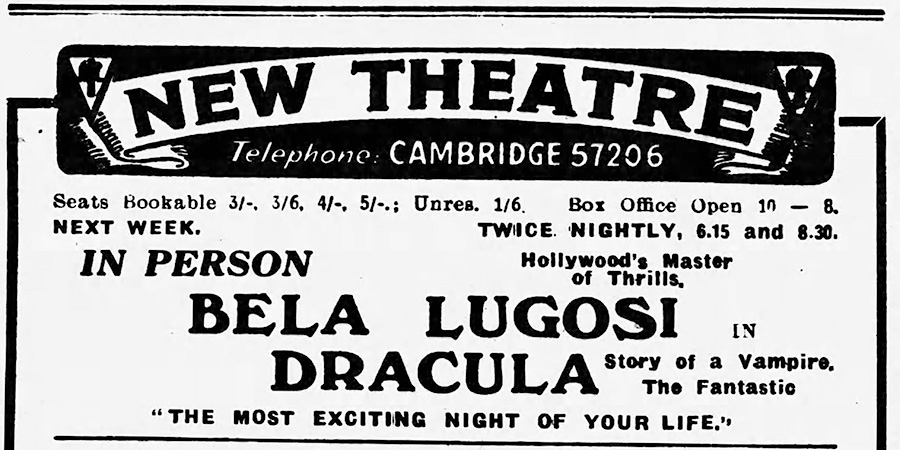
The tour of the provinces, therefore, was left to drag on, and on, and on, stretching eventually to twenty-four weeks, with Lugosi, in spite of his obvious physical fatigue, obliged to keep twirling his cape and snarling, twice daily, in areas of the country that he had never expected to venture. The venues, aside from Brighton, would include Lewisham, Golders Green, Streatham Hill, Dudley, Eastbourne, Shepherd's Bush, Glasgow, Middlesborough, Belfast, Wood Green, Manchester, Norwich, Leicester, Sheffield, Chatham, Luton, Nottingham, Chiswick, Cambridge, Derby and, finally, Portsmouth (publicists also arranged for him to conduct numerous interviews with the press, meet and mingle with each town's VIPs and make an appearance on the BBC radio show In Town Tonight, and they even had him opening Gillingham Park Fete and cutting the red ribbon at a new wet pea cannery at the Bachelors factory in Sheffield).
Even more dates were planned, moving back up to Newcastle and Liverpool, but Lugosi insisted that they be scrapped. He was, he said, simply too tired to go on any longer. The production thus came to an end on 13th October, not with a fang but with a whimper.
It had worn the actor out, mentally as well as physically. There were reports that he would go on in Act III but launch into dialogue that belonged in Act I, or forget his lines entirely and try to compensate by shuffling around the stage slipping in and out of the shadows. There were furtive injections, administered by his wife in his dressing room, of various drugs into his mauve-mottled arm before and during performances to keep him functioning, followed by similarly clandestine drinks to blank out the memory of each new setback.
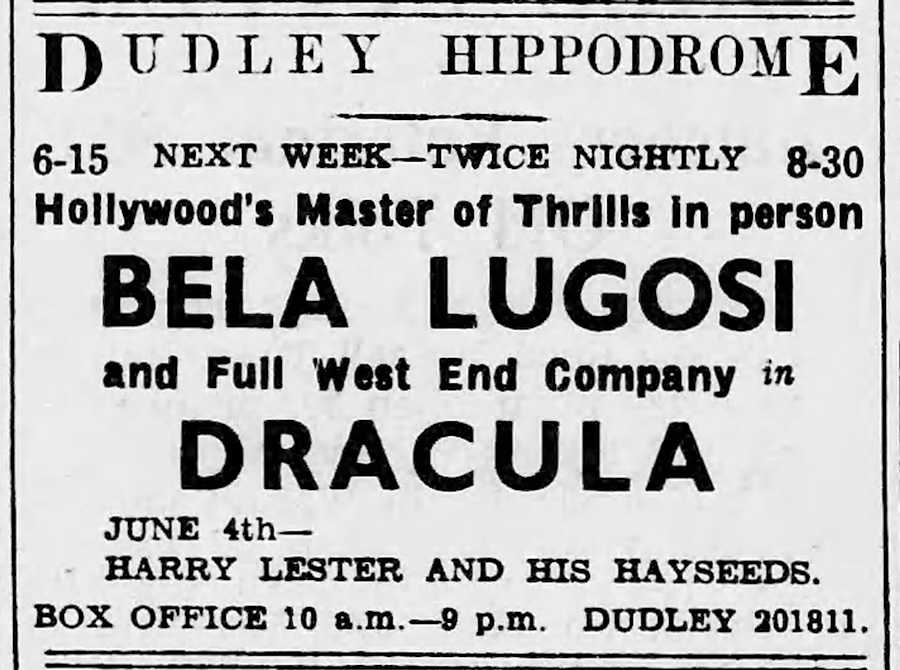
He turned sixty-nine the week after the tour ended, but looked a decade older than that once all of the pancake makeup had been peeled off. As his hopes had shrivelled, so had he, and, with the chill of autumnal England beginning to bite, his future seemed bleak.
There was, however, one further, albeit small, ray of hope for Lugosi's British adventure, and that was the prospect of making another movie. It had been back in July, while the tour was still trundling aimlessly on, that another producer, George Minter (a forty-year-old Londoner who had founded the Renown Pictures Corporation), in collaboration with his younger colleague Richard Gordon, had decided to take a gamble on exploiting what was left of Lugosi's lustre, announcing to the Sunday Mirror that he was planning a project that would team up the actor with the comedian behind the character of Old Mother Riley, Arthur Lucan (below).
By the end of September, having settled all the contractual matters and chosen between two sample scripts, Minter was able to confirm that the title would be Mother Riley Meets The Vampire (or Vampire Over London for certain other countries), and that filming would commence just as soon as Lugosi had completed his tour. The preferred screenplay (by Val Valentine) would amount to little more than a clumsy rehash of Abbott and Costello Meet Frankenstein, but the formulaic fare was all that Minter required to rush the low-budget film ahead.
The main thing on which he was relying was the potential chemistry to be shared by Lugosi and Lucan, and there were a few reasons why he was hopeful that such an unlikely partnership would prosper. The two men, for better or worse, had a surprising amount in common.
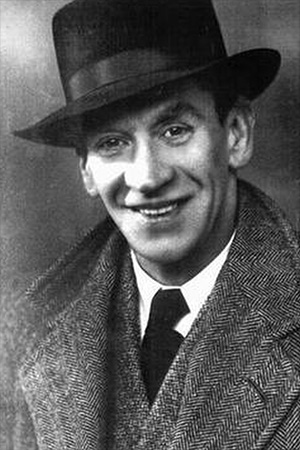
Aside from being of a similar age (there were only three years between them), Lucan, like Lugosi, had been a big star (one of Britain's major box office successes during the 1930s and 40s) who was now down on his luck (having recently lost most of his life savings of £30,000, and still owing £10,000 in taxes). Both of them had long been encaged by the character that had made their name (Lucan had been dragging up as the Irish washerwoman for almost as long as Lugosi had been donning the cape of Dracula); both were rather timid and sweet-natured men married to younger, stronger, and far more outspoken women (Lillian, who was good-intentioned but often overly-controlling, was twenty-nine years Lugosi's junior, while Lucan's alarmingly violent wife, the widely despised Kitty McShane, was eleven years younger); and both were now addicts of drink and/or drugs.
Minter's initial motivation had been to help his friend Lucan escape from Kitty's claws and reclaim his career, but he soon felt a similar sympathy for the plight of Lugosi. Together, he believed, they might rekindle each other's competitive spirit and recover some professional pride.
The plot was to pit Lugosi's mad scientist, Baron Von Housen, against Lucan's Mother Riley, who is now running a small grocery shop. A succession of young women have been abducted and killed, and another has just gone missing. The newspapers are speculating that it is the work of a modern-day vampire.
Scotland Yard suspects that it is the work of Von Housen, mainly because he is known to be 'a fanatical scientist' who sleeps in a coffin and is supported by 'a stupid gang of men who have allowed themselves to be mesmerised by legend'. Mother Riley, meanwhile, is being besieged by another kind of bloodsucker - a rent collector - due to her being eight weeks in arrears.
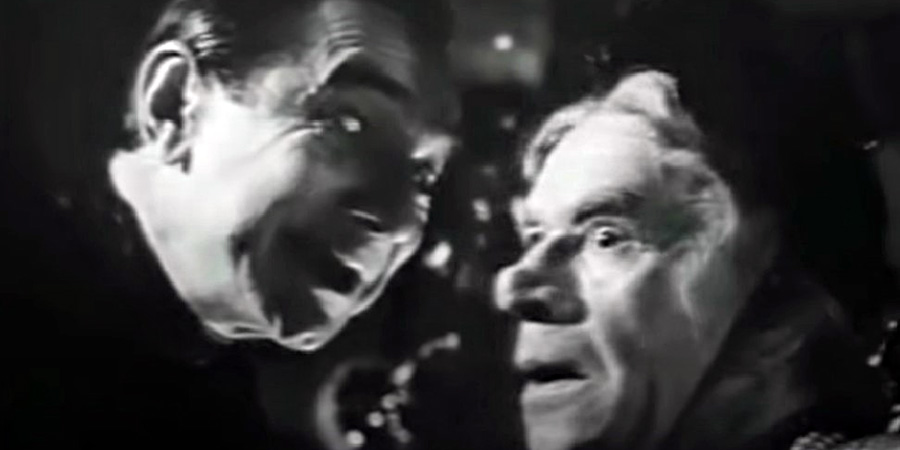
Von Housen, hidden away in a shadowy mansion, is planning to build fifty-thousand robots and take over the world, but, having already run out of uranium after making just one, he has kidnapped a woman who possesses a map to more of his key resources. Unfortunately for him, however, his first robot has been misdirected from a workshop in Ireland to Mother Riley's shop in London, while the contents of her recent modest family inheritance have ended up with him. The remainder of the movie would see Riley struggle against Von Housen to ensure that good wins out over evil.
Filming began at Nettlefold Studios (now Walton Studios) in Walton-on-Thames in Surrey on 5th November, and would last for the rest of the month. It was not, however, without some off-camera conflict.
One problem concerned Lugosi's uneasiness when working with Lucan. It was not that he lacked a sense of humour - far from it, he had a cultured appreciation of all things comical - but simply that he was often confused and discomforted by how comedians like Lucan approached their acting. He expected them, like him, to learn their lines, block out their movements and then proceed in a predictable and disciplined way.
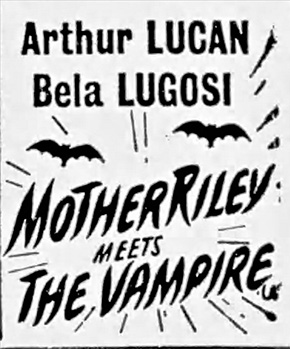
The likes of Lou Costello, for example, would not act like that. They would treat what was in the script merely as a starting point, some basic raw material, and then improvise on the set, and gauge the reaction of the technical crew, until they had found something that made more sense to their personal comic perspective.
Working alongside Costello on the Frankenstein spoof, therefore, had sometimes been torture for Lugosi, who was often left waiting in vain for the comedian to give him, or respond to his, cues, as the comedian preferred instead to leave him bemused as he ad-libbed lines and introduced new bits of business.
It was now much the same with Arthur Lucan. Lugosi had far less to do with him than he had been obliged to do with Costello, but the rehearsals were still a cause of some frustration. A master of making full use of atmospheric lighting effects, ensuring that his body and face caught exactly the right combination of light and shadow to heighten the horror, he was, understandably, exasperated by Lucan's apparent inability, or disinclination, to stick to the same movements and say the same lines from one take to the next.
Lucan, meanwhile, had his own problem, and his own problem was Kitty McShane. Outraged that she had been shut out of her estranged husband's new project (the first time that she was not set to share the screen with him), and furious at his freedom from her usual orders and interventions, she took to turning up each day at the studio to abuse him, disrupt the shooting and generally cause as much chaos as possible. Peace was only restored when George Minter stepped in to bar her from the premises.
Minter would indeed prove to be, in this and many other ways, a very hands-on kind of producer. While, for example, both the production and directing duties of the project had been formally assigned to John Gilling, one of Britain's busiest B-movie makers, Minter was often the man pulling the strings, having an input into everything from camerawork to casting.
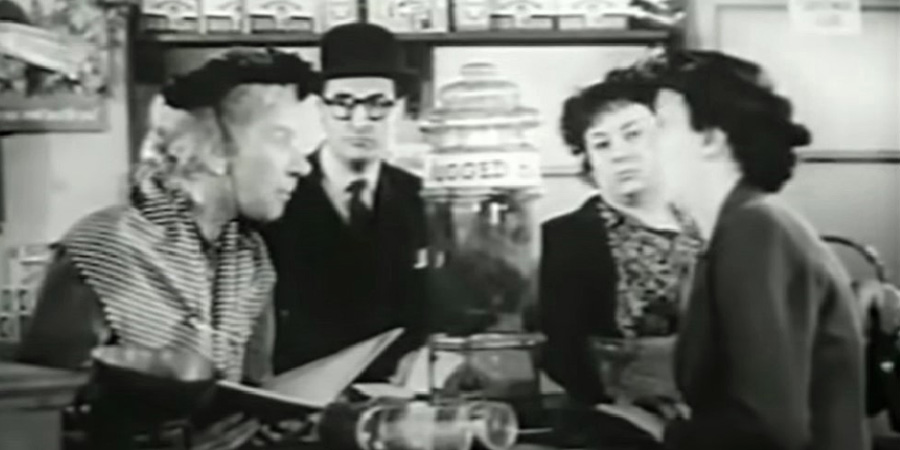
The professionalism of the supporting cast, in particular, would prevent the movie from suffering too obviously from its sub-standard script. Besides the sheer novelty of the central Lucan and Lugosi double act, the movie would also provide an early sighting of those two fine performers Hattie Jacques and Dandy Nichols, who appeared in a couple of early scenes as Mrs Jenks, a regular Cockney customer at Mrs Riley's shop ('Got any eggs, ducks?') and Mrs Mott ('I'll come back later for the "you know"').
They even get the chance to share one of the few half-decent bits of dialogue:
RILEY: What does he do with his victims?
JENKS: He drinks their blood.
RILEY: Ooh! Drinks their blood?
MOTT: Every drop.
RILEY: Every drop?
MOTT: Every drop.
RILEY: What a thirst!
JENKS: Yes, and he only picks beautiful young unattached girls.
RILEY: That's US!
There is also a relatively small but very cleverly-accentuated appearance by Dora Bryan as a nosy but nervous maid ('Ooh, I do feel peculiar!'), with Richard Wattis as her hyper-cautious police constable boyfriend ('If the old boy prefers a coffin, well, that's his funeral'), as well as a blink and you'll miss it contribution from John Le Mesurier - he ambles past Lugosi in a scene set at the docks - but his presence was left uncredited.
Thanks to all of their help, the movie turned out to be vastly superior to its uninspired (and, in its use of racial stereotypes, sometimes downright offensive) predecessor, Old Mother Riley's Jungle Treasure, but it was still a fairly dire affair, and, arguably, its most egregious weakness was its failure to make the most of the combination of its two co-stars. Although the move was called Mother Riley Meets The Vampire, Mother Riley only actually gets to meet the vampire for about five out of its seventy-four minutes.
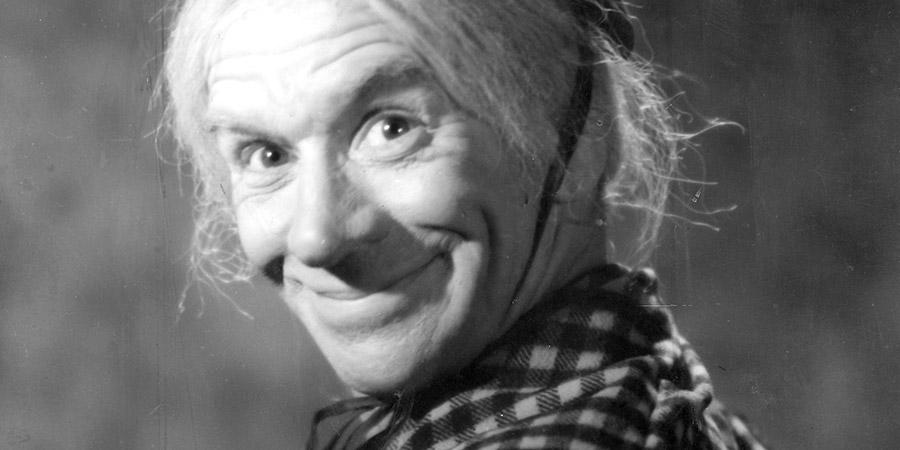
It is more than half an hour into the movie when they have their sole significant scene together, and that only lasts three minutes - which is a pity, because there is something undeniably fascinating about the sight of these two hugely experienced performers striving to blend their very different styles into something that works on the screen. Roger Lewis, in his fine essay Freaks, observed that, aside from the 'almost voyeuristic' feeling of watching 'the desperation of two fallen sozzled artistes at the end of their careers,' there is also the richer sense of pathos that comes from seeing 'the vampire and the transvestite, both disturbingly ambivalent creatures when you think about it (the one half-dead and half-alive, the other half-man and half-woman), enter each other's loneliness'.
They meet in the dark sepulchral gloom of Von Housen's dining room. The vampire, slickly black and slow-moving, finds the washerwoman, a scrawny bag of bones wrapped in rags, gazing up at a painting of his brother. 'Do you like bats?' he hisses. 'No, I hate them,' she replies. 'They give me cold shivers up and down me brisket!'
The remainder of the scene has Von Housen hold his stillness for the cold white light while Mrs Riley dodges in and out of the shadows with an air of restless twitchiness. 'Wouldn't you prefer a nice, juicy steak, about two inches thick, underdone, lovely and red in the middle?' he purrs seductively. 'And liver for breakfast - plenty of liver, with the blood coming out of it...?'
That, alas, is more or less the end of it. Apart from a few more seconds later on, Lugosi and Lucan have nothing more to do with each other, and the movie staggers to an end without even trying to tie up most of its loose ends.
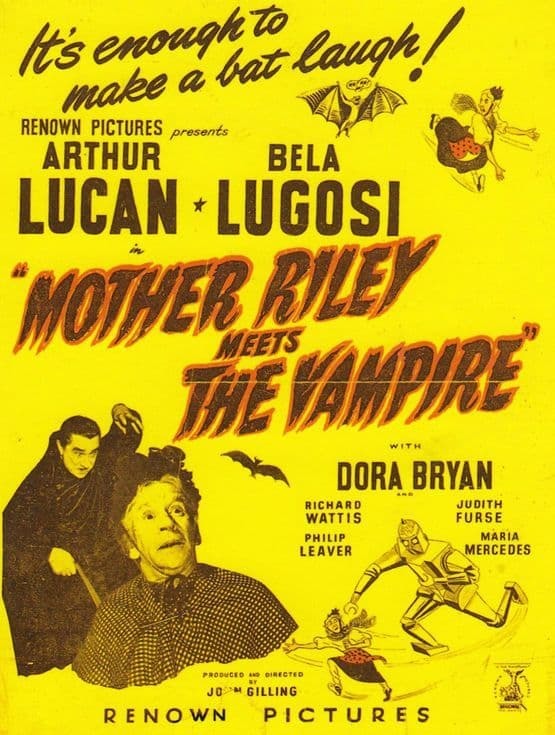
When it was released in UK cinemas in July 1952, the initial reception was, to be generous, mixed. The provincial British critics, on the whole, strained to sound enthusiastic, with one of them describing the movie as 'infallible knockabout fun,' and another insisting it was not only the 'best, and funniest, Mother Riley comedy' but also 'one of the most hilarious comedies seen for a long time,' but the more prominent metropolitan reviewers were damning, with Picturegoer's critic dismissing it as a 'lumbering collection of badly timed chestnuts,' while the Monthly Film Bulletin went further, denouncing it as 'stupid, humourless and repulsive'. It would fare no better in America, where it only had a limited release and failed to get any significant reviews at all.
Neither Lugosi nor Lucan would benefit from the venture. Neither man's decline could be arrested.
Arthur Lucan was left to struggle on with his stage act (whilst continuing, with remarkable generosity, to send part of his meagre earnings to the embittered Kitty McShane). There had been talk by Minter of further Mother Riley films, but the words never led to deeds.
Lucan died, soon after collapsing in the wings at the Tivoli Theatre in Hull, on 17th May 1954 at the age of sixty-eight. His stage creation would outlive him, rather cruelly, thanks to his widow's cynical decision to tour with one of his understudies, Roy Rolland, in his place.
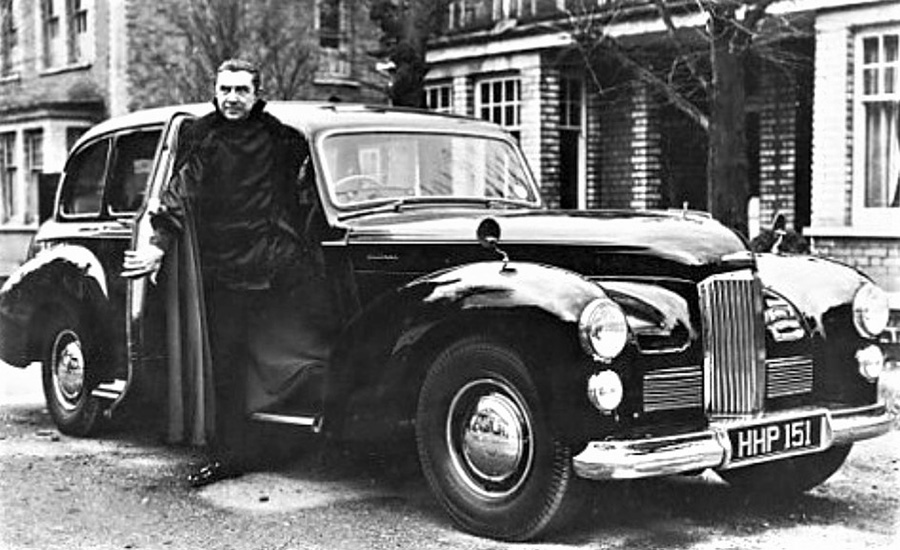
Bela Lugosi and his wife left England on 5th December 1951, sailing off to New York on board the Queen Elizabeth. Once back in America, he was faced with the same disappointments as before, and he sank ever more desperately into a reliance on drink and drugs.
His final few years (covered well, like the rest of his career, by the excellent Bela Lugosi Blog) would be hard ones, dogged by domestic disruptions and professional disappointments. He got divorced, remarried for a fifth time, publicly acknowledged his dependency on drugs (and underwent three months of treatment in the psychopathic ward at Los Angeles General Hospital) and started working, for want of anything better, for the enigmatically inept director Ed Wood in such dubious dramas as Glen or Glenda. Dying, aged seventy-three, on 16th August 1956, the nearest he would get to his own Dracula-style return was his posthumous presence the following year (via some old and unrelated footage) in Wood's hypnotically horrible Plan 9 from Outer Space.
So spare a thought, this dark Halloween night, for one of the most venerable of vampires. Ironically enough, the world sucked far more out of him than he ever sucked out of it.
Béla Lugosi might not have scared (or, for that matter, amused) many people during his brief time in Britain, but he did make plenty of new friends. When the news later came about his subsequent struggles, his British admirers were among the many from all over the world who sent him words, and in some cases notes, of support.
'I was once nice to them,' he told a reporter as he wiped a tear from his eye. 'It all comes back to you.'
Help us publish more great content by becoming a BCG Supporter. You'll be backing our mission to champion, celebrate and promote British comedy in all its forms: past, present and future.
We understand times are tough, but if you believe in the power of laughter we'd be honoured to have you join us. Advertising doesn't cover our costs, so every single donation matters and is put to good use. Thank you.
Love comedy? Find out moreThe Old Mother Riley Collection

Fully restored Old Mother Riley collection - including Bridget's Night Out and the previously lost film, Old Mother Riley (1937).
"Arthur Lucan was a comedian of genius." - Rachael Low
Includes:
Old Mother Riley (1937)
Old Mother Riley In Paris (1938)
Old Mother Riley, MP (1939)
Old Mother Riley's New Venture (1949)
Old Mother Riley, Headmistress (1950)
Old Mother Riley's Jungle Treasure (1951)
Mother Riley Meets The Vampire (1952)
"Lucan at his best is a superb comedian." - Leslie Halliwell
First released: Friday 20th November 2015
- Distributor: Renown Pictures
- Region: All
- Discs: 3
- Catalogue: 1947150
![]() Buy and sell old and new items
Buy and sell old and new items
Search for this product on eBay
BCG may earn commission on sales generated through the links above.

